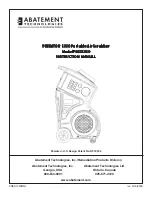
3
Note: The particulate filters in the PRED1200 do
not
remove odors, vapors or gases, including volatile organic
compounds.
Optional Vapor-Lock Carbon Filters (must be purchased separately)
CAUTION: For General Ventilating Use Only. Do Not Use To Exhaust Hazardous Or Explosive
Materials And Vapors. Refer to the REQUIREMENTS FOR SAFE OPERATION section of this manual.
Vapor-Lock
®
pleated, high-capacity, carbon filters (part # VL1002) are available for capturing OVG. This 2"-
deep filter can be used in place of the second-stage H502 pre-filter, to reduce airborne OVG by chemically
bonding the OVG molecules to the surface area of the carbon granules, via a process known as adsorption.
The VL1002 filter also provides a similar level of particulate filtration efficiency to the H502 pre-filter.
Effective carbon adsorption is dependent upon the amount of carbon & exposed carbon granule surfaces, and
the dwell (contact) time the OVG molecules have with the carbon granules. Operating the unit at lower speed
settings to increase dwell time can therefore improve OVG adsorption, though it is highly unlikely that all of the
OVG will be removed in one pass of air through the unit. Operating the unit in the recirculation mode can
increase effectiveness, by exposing OVG particles to multiple passes through the Vapor-Lock filter.
It is almost impossible to provide accurate estimates to two commonly asked questions: “how much time will it
take to capture all of the OVG?”, and “how do I know when a carbon filter should be replaced?” Unfortunately,
unknown factors, such as concentration levels, fresh-air intake volume, temperature, and humidity prevent
establishment of any more accurate ‘rule of thumb’ than one’s sense of smell. Since off-gassing of adsorbed
OVG can occur when the adsorption capacity of the filter is reached, replace the carbon filter as soon as odor
breakthrough is sensed. More detailed information on carbon adsorption can be found in an article titled:
“Activated Carbon: How Is It Used? How Does It Work?”
which can be found on the Links and Articles
page of the Mold Abatement, Restoration & Renovation products section of the Abatement Technologies
website,
www.abatement.com
.
TO DETERMINE THE REQUIRED NUMBER OF UNITS
Note: The Mold Abatement, Restoration & Renovation section of the Abatement Technologies website,
www.abatement.com
, includes a handy Air Change Calculator for all Predator models. This calculator provides
users with a simple way to determine how many units are needed to provide a given number of air changes
per hour (ACH) in any size containment area, and eliminates the need for user calculations. Simply enter the
dimensions of the containment area, the ACH required, and select a built-in safety factor (SF) to compensate
for potential losses due to filter loading, inlet and exhaust collars, ducting, etc. (Please note that use of a SF is
recommended but not required). The calculator does the rest.
To determine the number of units required without using the Air Change Calculator, proceed as follows:
1. Calculate the volume inside containment (V), in cubic feet, by multiplying the length of the area (L) x the
width of the area (W) x the ceiling height (H), in feet.
2. Determine the minimum ACH required in the job specification.
3. Select a safety factor (SF). Most users build-in between 10% (SF = 1.1) and 25% (SF = 1.25), or more.
If you don’t wish to use a SF, proceed to Step 4.
4. Calculate the minimum total airflow required (Total CFM), as follows:
Total CFM = (V x ACH x SF)
÷
60.
5. # Units Required = Total CFM
÷
CFM rating for the Unit.


































